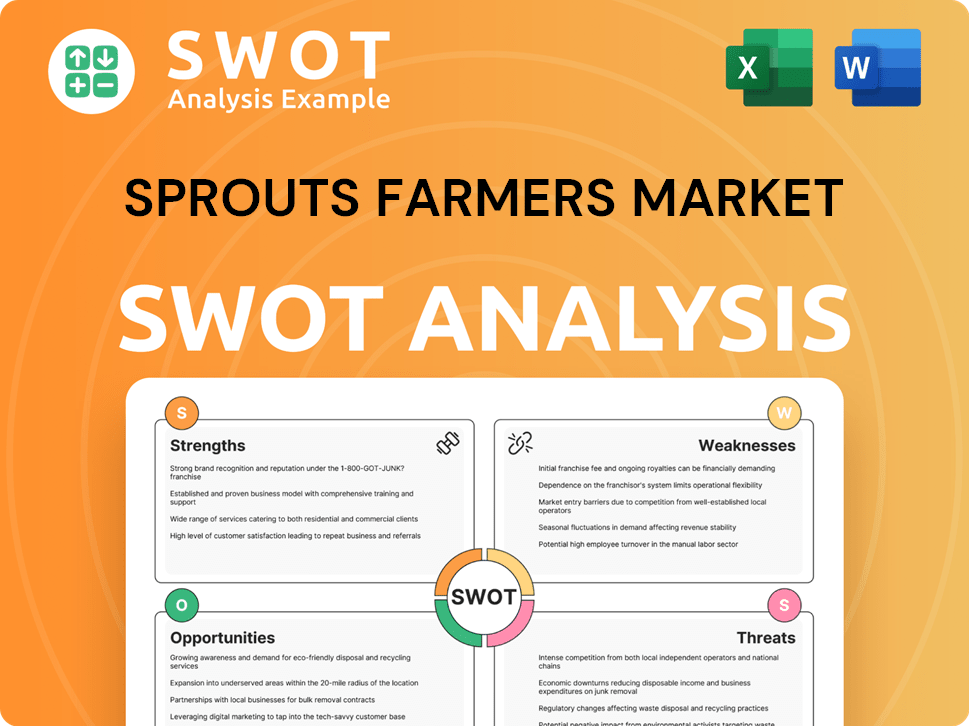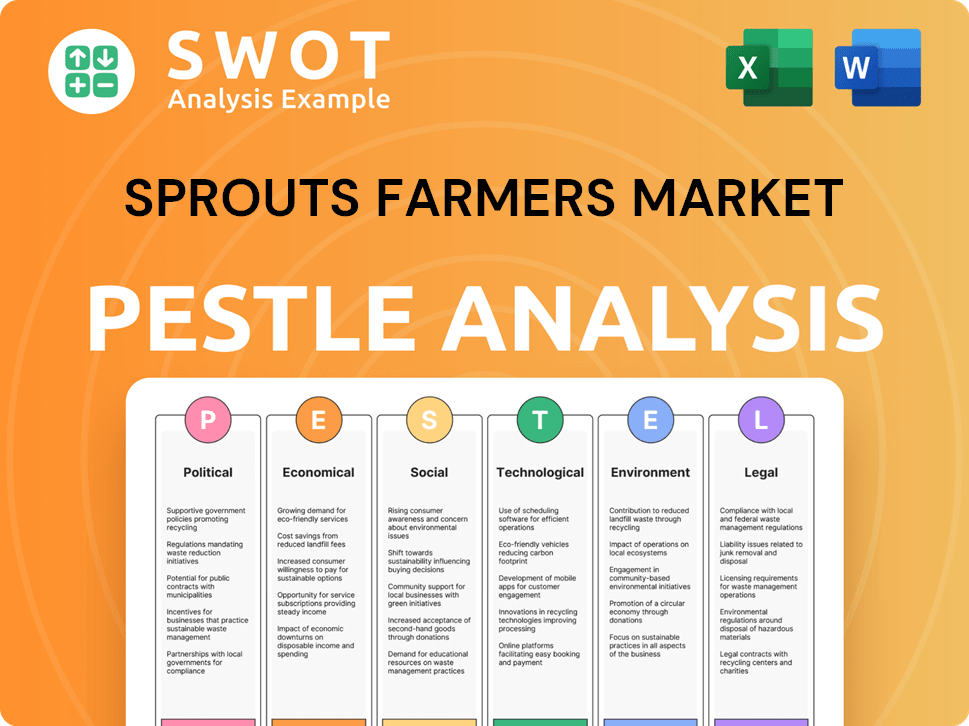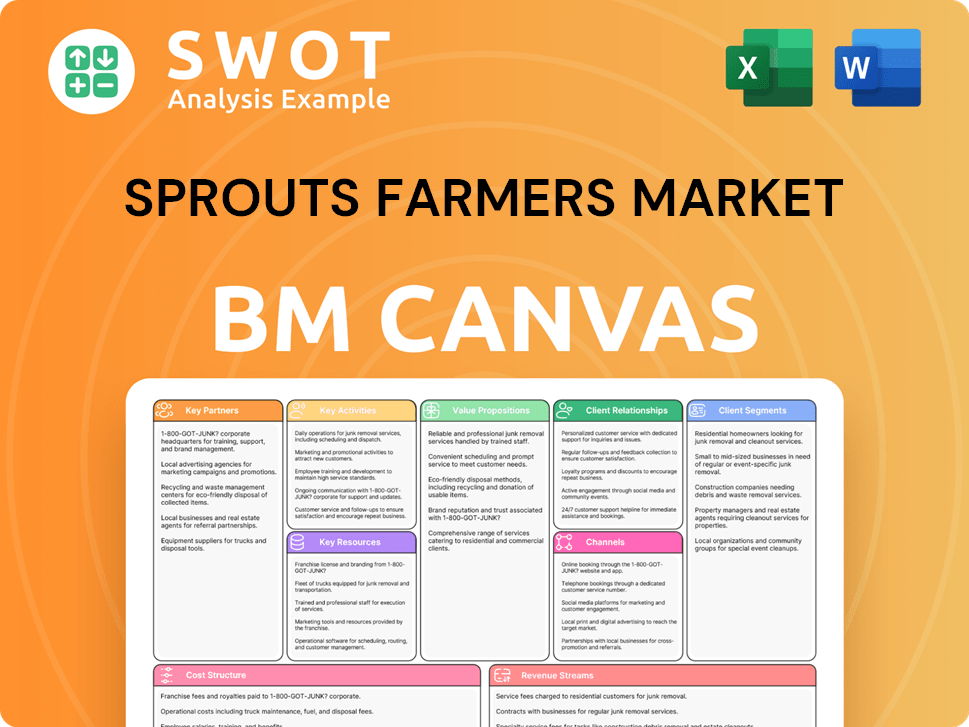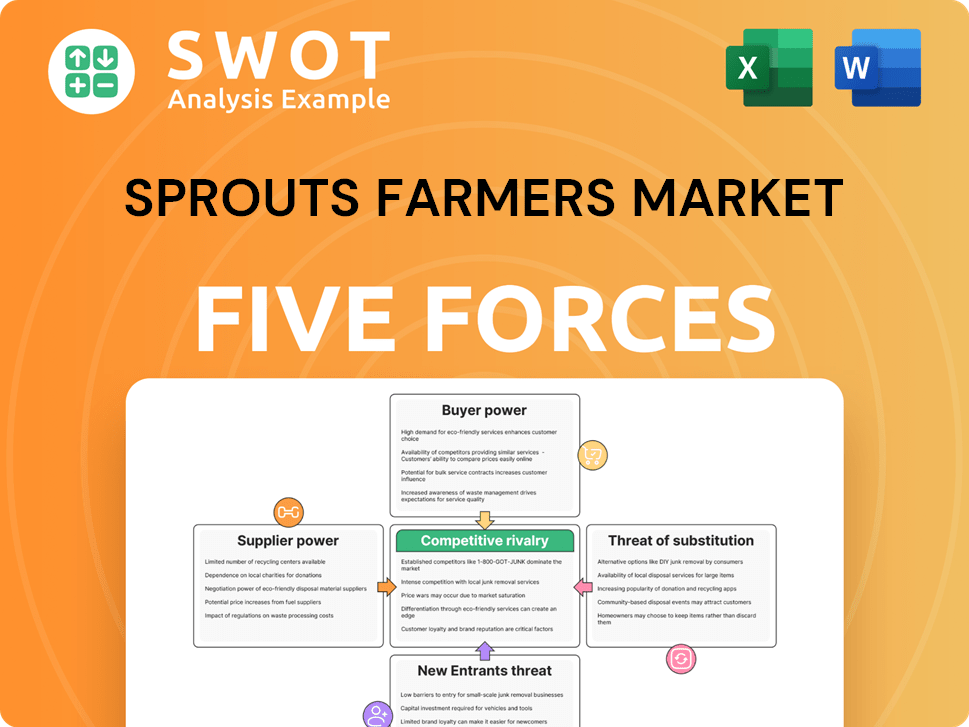Sprouts Farmers Market Bundle
How Does Sprouts Farmers Market Thrive in a Crowded Grocery Arena?
The grocery industry is a battlefield, and Sprouts Farmers Market has emerged as a key player in the health-focused segment. With the rising demand for organic and natural foods, understanding the Sprouts Farmers Market SWOT Analysis and its competitive positioning is crucial. This analysis dives deep into the Sprouts Farmers Market competitive landscape, exploring its strengths and weaknesses against its rivals.

This exploration of Sprouts Farmers Market's competitive landscape will identify its main competitors and dissect how it differentiates itself within the organic food market. We'll examine the company's strategic approach, assessing its market share analysis and financial performance compared to other healthy food retailers. Furthermore, we'll analyze the competitive advantages of Sprouts Farmers Market and its future growth projections.
Where Does Sprouts Farmers Market’ Stand in the Current Market?
Sprouts Farmers Market carves out a distinct market position within the U.S. grocery sector, primarily as a specialty retailer. Its focus is on natural and organic foods. The company competes within the dynamic Sprouts Farmers Market competitive landscape alongside major players like Whole Foods Market and Natural Grocers.
The core of Sprouts' business revolves around offering a wide array of products. These include fresh produce, bulk foods, vitamins, supplements, and natural meats. The company caters to consumers actively seeking healthier lifestyle options. This positioning allows Sprouts to stand out in the grocery store competition.
Geographically, Sprouts has expanded its footprint across more than 20 states. It's primarily concentrated in the West, Southwest, and Southeast regions of the United States. The company strategically targets markets where there's strong demand for its unique offerings. This approach is a key aspect of its Sprouts Farmers Market store locations and expansion strategy.
Sprouts specializes in natural and organic foods, setting it apart from conventional grocers. This focus allows the company to target a specific customer base. The company's emphasis on health and wellness is a key differentiator in the organic food market.
The product selection at Sprouts includes fresh produce, bulk foods, vitamins, and natural meats. They also offer dairy alternatives. This comprehensive range supports a health-conscious lifestyle. This wide variety helps in attracting a diverse customer base.
Sprouts operates across more than 20 states, with a strong presence in the West, Southwest, and Southeast. The company strategically selects locations with high demand for its products. This targeted approach supports its growth and market penetration.
Sprouts emphasizes value within the natural and organic space. It aims to make healthy eating accessible to a broader customer base. This strategy helps attract both price-sensitive and health-conscious consumers. This is a key element of its Sprouts Farmers Market pricing strategy analysis.
Financially, Sprouts has shown consistent performance, reporting approximately $6.8 billion in net sales for fiscal year 2023. This represents a 7% increase compared to the previous year. The company also reported a comparable store sales growth of 3.4%. This strong financial performance positions Sprouts favorably within the healthy food retailers segment. For more details on their strategic growth, you can read about the Growth Strategy of Sprouts Farmers Market.
Sprouts' financial health is a significant factor in its market position. The company's ability to maintain strong sales growth and comparable store sales growth indicates its resilience. This performance allows Sprouts to compete effectively in the grocery market.
- Net sales for fiscal year 2023 were approximately $6.8 billion.
- Comparable store sales growth was 3.4%.
- The company is well-positioned compared to many conventional grocers.
- Sprouts commands a strong presence in its specialized segment.
Sprouts Farmers Market SWOT Analysis
- Complete SWOT Breakdown
- Fully Customizable
- Editable in Excel & Word
- Professional Formatting
- Investor-Ready Format

Who Are the Main Competitors Challenging Sprouts Farmers Market?
The Marketing Strategy of Sprouts Farmers Market is significantly shaped by the competitive landscape it navigates. The company's success hinges on its ability to differentiate itself within a crowded market of grocery stores and health-focused retailers. Understanding its key rivals and their strategies is crucial for assessing its market position and future prospects.
The organic food market and the broader grocery industry are dynamic, with new players and evolving consumer preferences constantly reshaping the competitive environment. This analysis of the Sprouts Farmers Market competitive landscape provides an overview of its main challengers, both direct and indirect, and examines the strategies they employ to capture market share. The goal is to provide a comprehensive understanding of the competitive dynamics affecting Sprouts Farmers Market.
Sprouts Farmers Market faces a diverse range of competitors, each with unique strengths and strategies. The competitive landscape includes direct competitors like Whole Foods Market and Natural Grocers, as well as indirect competitors such as conventional supermarkets and mass merchandisers. This analysis aims to provide a clear picture of the competitive dynamics affecting Sprouts Farmers Market.
Direct competitors are those that offer similar products and target the same customer base. These rivals directly challenge Sprouts Farmers Market's market share.
Owned by Amazon, Whole Foods Market is a premium grocer known for its extensive selection of organic and gourmet products. It often competes with Sprouts Farmers Market on the higher end of the market.
Natural Grocers by Vitamin Cottage focuses on natural and organic products, similar to Sprouts. It often competes in similar geographic areas, emphasizing dietary restrictions and nutritional education.
Various regional chains also compete with Sprouts, offering natural and organic products tailored to local markets. These competitors vary by region and market presence.
Indirect competitors offer products that serve similar customer needs, even if they don't specialize in natural and organic foods. These rivals can impact Sprouts' market share by offering competitive pricing or convenience.
Kroger, Albertsons, and Publix have expanded their organic and natural food sections. They leverage their established customer bases and broader reach to compete on price and convenience.
Walmart and Target have entered the organic food space, using their purchasing power to offer lower prices. This can pressure Sprouts on value, especially in areas where these retailers are prevalent.
Costco offers organic products in bulk, appealing to consumers seeking value. This impacts Sprouts' market share by providing an alternative shopping channel for natural and organic products.
Amazon Fresh and Instacart provide online grocery delivery options, increasing competition. They offer convenience and can impact Sprouts' market share by providing alternative shopping channels.
The competitive landscape is also shaped by emerging players and evolving business models. Meal kit delivery services and direct-to-consumer organic food brands are gaining traction, offering convenience and curated selections. Mergers and alliances, such as Amazon's acquisition of Whole Foods, have intensified competition by integrating online and offline retail experiences. Sprouts' ongoing challenge is to differentiate itself effectively against these diverse competitors, whether through unique product offerings, superior customer experience, or competitive pricing in its specialized niche.
Several factors drive competition in the organic and natural foods market. These include pricing, product selection, store location and convenience, customer service, and brand reputation. Understanding these factors is crucial for Sprouts to maintain and grow its market share.
- Pricing: Competitive pricing is essential, especially against mass merchandisers and conventional supermarkets.
- Product Selection: Offering a wide variety of organic and natural products, including private-label brands, helps attract customers.
- Store Location and Convenience: Convenient locations and store layouts enhance the shopping experience.
- Customer Service: Providing excellent customer service and a positive shopping environment builds customer loyalty.
- Brand Reputation: Building a strong brand reputation for quality and value is crucial.
Sprouts Farmers Market PESTLE Analysis
- Covers All 6 PESTLE Categories
- No Research Needed – Save Hours of Work
- Built by Experts, Trusted by Consultants
- Instant Download, Ready to Use
- 100% Editable, Fully Customizable

What Gives Sprouts Farmers Market a Competitive Edge Over Its Rivals?
The business model of Sprouts Farmers Market centers on a unique approach to the grocery sector. This strategy allows it to carve out a distinct niche within the highly competitive landscape. By focusing on fresh, natural, and organic products, the company aims to attract health-conscious consumers. This focus is a key element in understanding the company's competitive advantages.
A core element of the company's strategy is its store format. The design is meant to mimic a farmers market, creating an appealing shopping environment. This design, combined with a focus on fresh produce, differentiates it from conventional supermarkets. This differentiation is crucial in the face of increasing grocery store competition.
The company has shown consistent financial performance. In 2023, the company reported net sales of approximately $6.8 billion. This performance indicates a strong position in the organic food market. This performance is a testament to its effective competitive advantages.
The store layout and product selection are significant competitive advantages. The farmers market atmosphere, with fresh produce at the forefront, attracts customers. This design choice differentiates from traditional supermarkets. The focus on natural and organic products is a key element of its appeal.
The company offers competitive pricing within the natural and organic category. This approach makes healthy eating more accessible to a broader customer base. Promotional deals and bulk purchasing options contribute to this value proposition. This strategy helps attract customers looking for quality and affordability.
An efficient supply chain supports the company's ability to offer fresh produce at competitive prices. Direct sourcing from local and regional farms plays a role in maintaining product quality. This approach contributes to the company's ability to offer competitive pricing.
The company benefits from its reputation for freshness and health-conscious products. A friendly shopping environment and knowledgeable staff enhance the customer experience. Private label offerings further strengthen the brand and provide exclusive products. These factors contribute to customer loyalty and repeat business.
The company's competitive advantages include its unique store format, value proposition, and efficient supply chain. These factors contribute to its ability to differentiate itself in the Sprouts Farmers Market competitive landscape. These advantages have helped the company maintain a strong position in the market.
- Unique store format and product assortment.
- Competitive pricing in the natural and organic segment.
- Efficient supply chain and direct sourcing.
- Strong brand equity and customer loyalty.
Sprouts Farmers Market Business Model Canvas
- Complete 9-Block Business Model Canvas
- Effortlessly Communicate Your Business Strategy
- Investor-Ready BMC Format
- 100% Editable and Customizable
- Clear and Structured Layout

What Industry Trends Are Reshaping Sprouts Farmers Market’s Competitive Landscape?
The competitive landscape for Sprouts Farmers Market is dynamic, influenced by evolving consumer preferences and industry trends. The company's position is shaped by its focus on natural and organic foods, offering a differentiated shopping experience. Understanding the Sprouts Farmers Market competitive landscape, including its main rivals and the broader grocery store competition, is crucial for assessing its future prospects. This Sprouts Farmers Market analysis considers the current market dynamics, potential risks, and growth opportunities.
Sprouts faces a blend of challenges and opportunities as the grocery industry evolves. The rising demand for organic and health-conscious products aligns well with Sprouts' core offerings, presenting a significant growth avenue. However, the increasing importance of e-commerce and the rise of competitors in the organic food market require strategic adaptation. Furthermore, economic conditions and supply chain disruptions pose potential risks that could affect the company's performance.
The grocery sector is experiencing a strong demand for natural and organic products. E-commerce is rapidly growing, influencing consumer behavior. Technological advancements are changing supply chain management and marketing.
Intensified competition from traditional grocers and online retailers is a key challenge. Economic downturns and supply chain disruptions could impact sales and profitability. Maintaining competitive pricing while offering quality is crucial.
Expanding into new markets with high demand for natural foods is a significant opportunity. Developing e-commerce capabilities and innovating in private label products can drive growth. Strategic partnerships can also boost its competitive position.
Sprouts is focusing on store efficiency and enhancing customer experiences. The company is expanding its geographic footprint strategically. They are also investing in online grocery services and private label offerings.
Sprouts should focus on strengthening its e-commerce platform and delivery options to compete effectively. Further expansion into regions with strong demand for natural foods could boost growth. The company needs to maintain a balance between competitive pricing and product quality to retain its customer base.
- Sprouts Farmers Market vs Whole Foods Market comparison reveals differing strategies in pricing and product selection.
- Analyzing Sprouts Farmers Market market share analysis is crucial for understanding its position in the healthy food retailers sector.
- Understanding Sprouts Farmers Market customer demographics helps tailor marketing strategies.
- Exploring Sprouts Farmers Market competitive threats and opportunities is essential for long-term planning.
To further understand the company's strategic approach, you can examine the Growth Strategy of Sprouts Farmers Market. This article provides deeper insights into the company's initiatives.
Sprouts Farmers Market Porter's Five Forces Analysis
- Covers All 5 Competitive Forces in Detail
- Structured for Consultants, Students, and Founders
- 100% Editable in Microsoft Word & Excel
- Instant Digital Download – Use Immediately
- Compatible with Mac & PC – Fully Unlocked

Related Blogs
- What are Mission Vision & Core Values of Sprouts Farmers Market Company?
- What is Growth Strategy and Future Prospects of Sprouts Farmers Market Company?
- How Does Sprouts Farmers Market Company Work?
- What is Sales and Marketing Strategy of Sprouts Farmers Market Company?
- What is Brief History of Sprouts Farmers Market Company?
- Who Owns Sprouts Farmers Market Company?
- What is Customer Demographics and Target Market of Sprouts Farmers Market Company?
Disclaimer
All information, articles, and product details provided on this website are for general informational and educational purposes only. We do not claim any ownership over, nor do we intend to infringe upon, any trademarks, copyrights, logos, brand names, or other intellectual property mentioned or depicted on this site. Such intellectual property remains the property of its respective owners, and any references here are made solely for identification or informational purposes, without implying any affiliation, endorsement, or partnership.
We make no representations or warranties, express or implied, regarding the accuracy, completeness, or suitability of any content or products presented. Nothing on this website should be construed as legal, tax, investment, financial, medical, or other professional advice. In addition, no part of this site—including articles or product references—constitutes a solicitation, recommendation, endorsement, advertisement, or offer to buy or sell any securities, franchises, or other financial instruments, particularly in jurisdictions where such activity would be unlawful.
All content is of a general nature and may not address the specific circumstances of any individual or entity. It is not a substitute for professional advice or services. Any actions you take based on the information provided here are strictly at your own risk. You accept full responsibility for any decisions or outcomes arising from your use of this website and agree to release us from any liability in connection with your use of, or reliance upon, the content or products found herein.